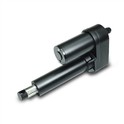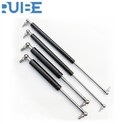Hey there! As a supplier of lockable gas springs, I've been getting a lot of questions lately about integrating these nifty devices into robotic systems. So, I thought I'd share some insights on the integration requirements for using a lockable gas spring in a robotic setup.
First off, let's talk about what a lockable gas spring is. It's a type of gas spring that can be locked in a specific position, providing support and stability when needed. These springs are commonly used in various applications, such as Lockable Gas Spring for Sofa, Gas Spring for Chair, and Lockable Gas Spring for Table. But when it comes to robotics, there are some unique considerations.
1. Load Capacity
One of the most critical integration requirements is ensuring that the lockable gas spring can handle the load. Robotic systems come in all shapes and sizes, and each has its own weight and force requirements. You need to accurately calculate the maximum load that the spring will need to support. This includes the weight of the robotic arm, any attached tools or sensors, and the forces generated during operation.
For example, if you're using the gas spring to support a heavy robotic gripper, you'll need a spring with a high load capacity. On the other hand, for a lightweight robotic end - effector, a spring with a lower load capacity might be sufficient. Make sure to check the load - rating specifications provided by the manufacturer and choose a spring that can comfortably handle the expected load.
2. Stroke Length
The stroke length of the lockable gas spring is another important factor. The stroke length refers to the maximum distance that the spring can extend and retract. In a robotic system, you need to determine the range of motion required for the particular application.
Let's say you're building a robotic arm that needs to reach a certain distance. The stroke length of the gas spring should be long enough to accommodate this movement. If the stroke length is too short, the robotic arm won't be able to reach its full range of motion. Conversely, if it's too long, it might cause unnecessary stress on the spring and other components of the system.
3. Locking Mechanism Compatibility
The locking mechanism of the gas spring needs to be compatible with the robotic control system. In a robotic setup, you'll likely want to be able to lock and unlock the spring at specific times and positions. This requires a locking mechanism that can be easily controlled.
Some lockable gas springs use manual locking mechanisms, which might not be suitable for robotic applications. For robotics, you'll typically need an electronically or pneumatically controlled locking mechanism. This way, you can integrate the locking function into the overall control system of the robot. For instance, you can program the robot to lock the gas spring when it reaches a certain position to hold it steady during a specific task.
4. Mounting and Installation
Proper mounting and installation are crucial for the successful integration of a lockable gas spring into a robotic system. The spring needs to be mounted securely to ensure that it can function correctly and safely.
You'll need to consider the mounting points on both the robotic component and the spring itself. The mounting points should be designed to handle the forces and vibrations generated during operation. Additionally, the orientation of the spring is important. Incorrect orientation can lead to uneven wear on the spring and reduced performance.
5. Environmental Conditions
Robotic systems can operate in a wide range of environmental conditions. You need to make sure that the lockable gas spring can withstand these conditions.
For example, if the robot is used in a dusty or dirty environment, the spring should have a protective coating or sealing to prevent debris from entering and damaging the internal components. In a high - temperature environment, the spring should be made of materials that can withstand the heat without losing their mechanical properties. Similarly, in a corrosive environment, corrosion - resistant materials should be used.
6. Response Time
In a robotic system, the response time of the lockable gas spring is essential. When the control system sends a signal to lock or unlock the spring, it should respond quickly.


A slow response time can lead to delays in the robot's operation, which can affect the overall efficiency and accuracy of the system. For high - speed robotic applications, a spring with a fast response time is crucial. You need to choose a spring that can meet the response - time requirements of your specific robotic system.
7. Compatibility with Other Components
The lockable gas spring needs to be compatible with other components in the robotic system. This includes the control system, power supply, and any sensors or actuators.
For example, if you're using an electronically controlled locking mechanism, it should be able to communicate effectively with the robot's control board. The power requirements of the spring's locking mechanism should also be compatible with the available power supply in the robotic system.
8. Maintenance and Serviceability
Finally, consider the maintenance and serviceability of the lockable gas spring. Robotic systems often need to operate continuously for long periods, and regular maintenance is necessary to ensure optimal performance.
Choose a spring that is easy to access and maintain. This might include features such as removable end - fittings or easy - to - clean surfaces. Additionally, the manufacturer should provide clear instructions on maintenance procedures and replacement parts availability.
In conclusion, integrating a lockable gas spring into a robotic system requires careful consideration of several factors. From load capacity and stroke length to locking mechanism compatibility and environmental conditions, each aspect plays a crucial role in the successful operation of the system.
If you're looking to incorporate a lockable gas spring into your robotic project, don't hesitate to reach out. We have a wide range of high - quality lockable gas springs that can meet your specific requirements. Whether you need a spring for a small, lightweight robot or a large, heavy - duty industrial robotic system, we've got you covered. Let's have a chat about your project and find the perfect lockable gas spring solution for you.
References
- Engineering Handbook of Gas Springs, Manufacturer's Manual
- Robotics Design and Integration Guidelines, Industry Standard Documents






